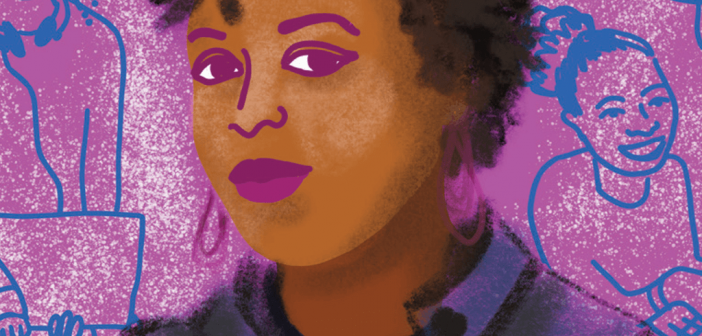 It’s not often we get a chance to showcase nonfiction, but when we do, it’s always exciting—and today’s excerpt is no different! Girl CEO, the new nonfiction book by Pulitzer Prize winner Katherine Ellison and former New York Times writer Ronnie Cohen, is for young entrepreneurs… and we have an excerpt for you!
It’s not often we get a chance to showcase nonfiction, but when we do, it’s always exciting—and today’s excerpt is no different! Girl CEO, the new nonfiction book by Pulitzer Prize winner Katherine Ellison and former New York Times writer Ronnie Cohen, is for young entrepreneurs… and we have an excerpt for you!
Girl CEO showcases 40 impressive women who have achieved success in industries including fashion, finance, music, media, sports equipment, toys, tech, and more. Ellison and Cohen studied these women and conducted interviews in order to share these inspiring stories and highlight the practical advice these women have picked up along the way. They chose a variety of leaders: icons like Oprah and Diane von Furstenberg, corporate powerhouses like Ursula Burns and Mary Barra, business-savvy entertainers like Taylor Swift and Reese Witherspoon, and more. They even spotlight teens who are already thriving in business and in life.
Girl CEO is available now. Keep reading for an introduction and the spotlight on Kimberly Bryant—complete with sample pages from the book to get the full illustrations!
INTRODUCTION
What do you want to be when you grow up? As the 40 women in this book demonstrate, your choices are limitless. Maybe you want to program robots to help kids with disabilities. Or create your own TV network. Or lead a major manufacturing company. Or start a doggy daycare franchise. Or be the first woman to—fill in the blank.
The world needs more women with big dreams. So let your imagination fly!
Haile Thomas and Rachel Zietz, two young women profiled in the book, had a clear idea about what they wanted to do when they were just 12 years old. Haile channeled her concern over her father’s diabetes diagnosis into a nonprofit organization. Rachel turned her love of lacrosse into a business. Other women in the book discovered their passion when they were well into their adult years. There’s no rush to decide as long as you enjoy the adventure of discovery. Then, whatever you choose, we hope you’ll wake up every morning, or at least most mornings, looking forward to going to work.
We also hope the women described in these pages inspire you on your journey, wherever it leads. Many of the women are entrepreneurs, which means they came up with an original idea for a company and then created it. Some of them run their own businesses as chief executive officers, or CEOs. Still others have “disrupted” their industries by changing the rules to their advantage.
We chose a diverse group of women, born as early as 1839 and as recently as 2004. They come from varied racial, ethnic, and economic backgrounds. Oprah Winfrey’s family was so poor when she was growing up in Mississippi that she wore dresses sewn from potato sacks. Joy Mangano was struggling to pay her electric bill and support her three young children when she invented her Miracle Mop. At the other extreme, Diane von Furstenberg benefited from the financial support and social ties of her husband, a wealthy prince, when she introduced her clothing line.
Most of the women earned college degrees. Four went on to earn advanced degrees in business administration. A few attended college on scholarships and financial aid. Not all completed college. LSTN founder Bridget Hilton went straight from high school to work in the music industry.
Some came to this country as immigrants or were born to immigrants. Because Hooked founder Prerna Gupta and YouTube star Lilly Singh, both children of immigrants, experienced the world as outsiders, they developed the kind of dogged determination entrepreneurs need to succeed.
Many of the women blazed new trails. Mary Barra worked her way up from GM’s factory floor to become the first woman CEO of a major automaker. Ursula Burns was the first African-American woman to lead a Fortune 500 company. Muriel Siebert was the first woman to own a seat on the New York Stock Exchange. Katharine Graham was the first woman publisher of a major American newspaper. Judy Faulkner started a medical software company in 1979, when very few women worked in technology.
Backed by their economic power, several of these entrepreneurs have revolutionized aspects of their industries. Pop star Taylor Swift has found new ways for musicians to control how their concert tickets are sold. Sheryl Sandberg, Facebook’s chief operating officer, has inspired women to “lean in” and power their way to the top of corporations. By teaching African-American girls to program computers, Kimberly Bryant, founder of Black Girls Code, intends to transform the face of the technology industry.
Each woman’s journey offers a different lesson. But we were struck by how much these leaders had in common.
Taking risks—an important part of an entrepreneur’s job—was a recurring theme. Rosanna Pansino invested her life’s savings to make her wildly popular Nerdy Nummies YouTube videos. Francesca Kennedy quit her high-paying job at a financial-services firm to sell sandals and provide jobs and clean drinking water in Guatemala.
Of course, sometimes taking risks can be dangerous. That’s just the point. Yet several women insisted that they learned more from failing than from succeeding. They stressed how important it was to pick themselves up after making a mistake. “I’ve learned that failure is just a step towards greatness,” said Heidi Ganahl, founder of Camp Bow Wow. “Don’t fear it, embrace it.”
When faced with challenges, many women turned to their families. Noa Mintz’s father helped her launch a website and register her babysitter service as a business. Alice Waters’ parents mortgaged their house so she could start her influential restaurant. Some women gave special credit to their mothers for encouraging them. The “fighter mentality” that Anne Wojcicki learned from her mother helped her endure a year when she almost lost control of her company, 23andMe.
Several women incorporated philanthropy into their companies after realizing customers were demanding products that pair charity with merchandise. Francesca Kennedy, Bridget Hilton, and Mikaila Ulmer knit social missions into the core of their businesses.
We wrote Girl CEO against the backdrop of a growing, social-media driven movement to empower women. The #MeToo and #TimesUp campaigns have exposed and challenged male harassment of women in the workplace. Regardless of how women’s opportunities change in the future, one thing will remain the same. It will continue to be up to every one of us to put in the effort and take the risks required to find and keep work that’s fulfilling—and pays the bills. The days of women being kept out of corporate boardrooms and top leadership roles are over—and good riddance, right? As these 40 women show, if you find your passion and work hard, the sky’s the limit. Write your own story.
— RONNIE COHEN AND KATHERINE ELLISON
KIMBERLY BRYANT
BE A ROLE MODEL
Kimberly Bryant was accustomed to being the only black woman in the room. She was the only one in her engineering and computer science classes at Vanderbilt University. After graduating in 1989, she was the only one in her office.
Bryant tried to brush aside how lonely she felt seeing no one who looked like her at school or work. But when she dropped off her 11-year-old daughter, Kai, at a coding summer camp, Bryant was stunned by what she saw.
“The class was literally still filled with boys, sprinkled with a handful of girls,” she said. “And Kai was the only student of color, boy or girl.”
On the drive home after the weeklong sleepaway camp, Kai told Bryant how much she loved designing video games. She also mentioned that the instructors paid more attention to the boys than the girls. Bryant’s heart sank. “I had seen this light in her eyes about all she learned. But I didn’t want it to get put out prematurely because she didn’t get the type of nurturing that she needed,” she said. “That was a moment for me to realize I needed to make a change if I wanted to see a change happen in my daughter’s world.”
Bryant embraced the moment. She began teaching her daughter and some of her friends to code. She wanted to inspire and excite the girls. And she wanted them to experience what she had not—to be surrounded by people who looked like them.
Soon after, Bryant quit her job at a biotechnology company and started a nonprofit called Black Girls Code. Its mission is to change the face of the computing workforce. Women held only 27 percent of technology jobs in the United States in 2017, according to the National Center for Women and Information Technology. The picture was even bleaker for African-American women. They held just 3 percent of the jobs.
Bryant taught the first series of Black Girls Code classes in 2011 in a San Francisco basement. Eight girls came and had to share six computers. At the time, people were just starting to realize how few women and minorities worked in tech. Bryant’s timing was right.
After the second six-week course, Google gave the group $20,000—its first grant. Since then, most of the nonprofit’s funding has come from corporate grants. In 2017, General Motors gave the organization $225,000 to open a Detroit chapter, its thirteenth.
The organization offers summer camps, weekend workshops, and after-school classes throughout the United States and in South Africa. Students learn basic coding skills and how to design web pages, game apps, and robots.
“I love looking around the room and seeing all the girls doing robotics or game design,” Bryant said. “That’s not something you see every day.”
Black Girls Code has connected more than 8,000 girls from underrepresented communities to technology and helped them master the skills necessary to become industry leaders. By 2040, it aims to reach 1 million girls.
One of the fun ways the nonprofit gets girls excited about technology is by sponsoring girls-only hackathons. During a hackathon, computer programmers work together to create new software or solve problems as a group. At one, Kai and her team developed an app to point hungry, homeless people in Oakland, California, to shelters with leftover restaurant food. The group’s hackathons also have produced tools to track lost pets and to connect students with mentors. One hackathon team developed an app called “takeAminute,” designed to help people relax by matching their behavioral symptoms with YouTube videos intended to calm and amuse them.
“Black Girls Code gives girls not just an opportunity to learn how to code but to use code as a tool for changing the world around them,” Bryant said.
She and Black Girls Code are changing the tech world one girl at a time.








